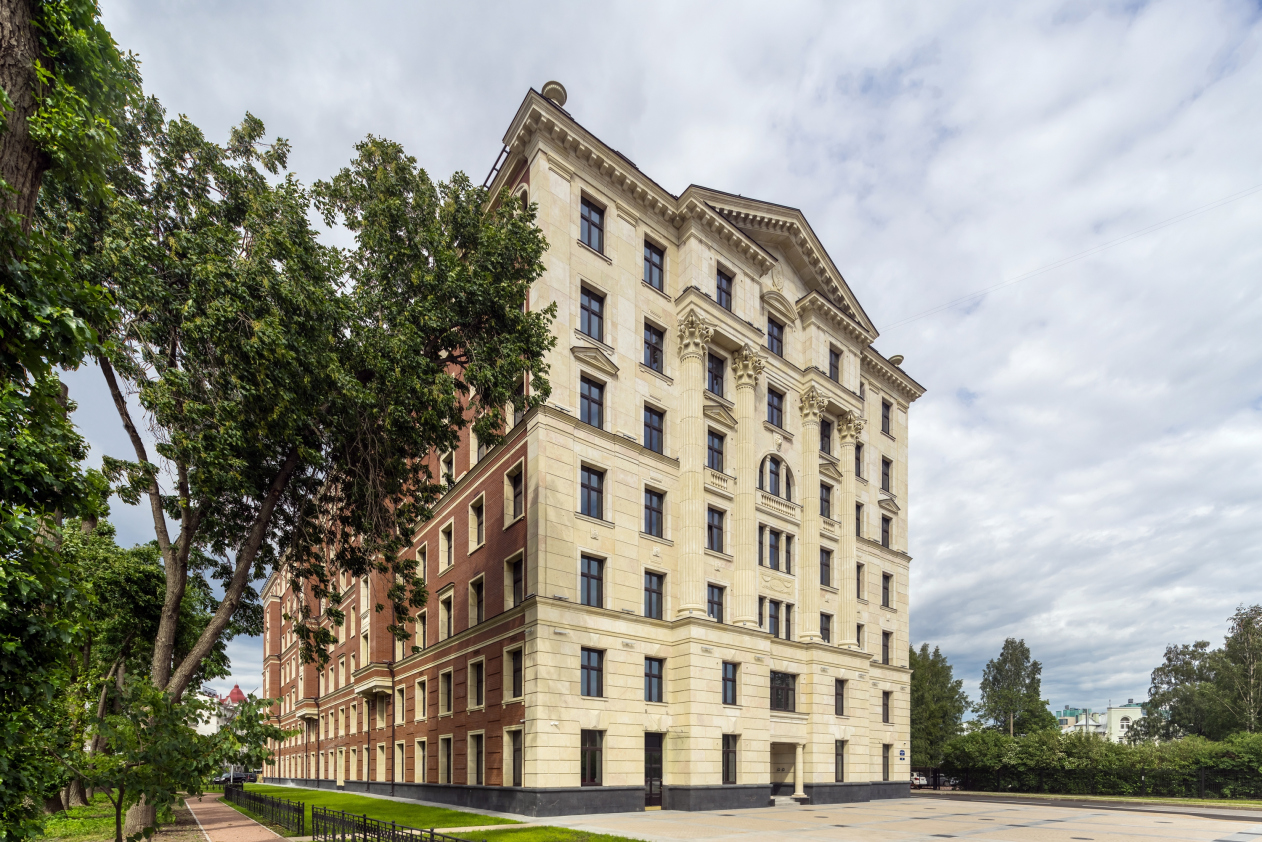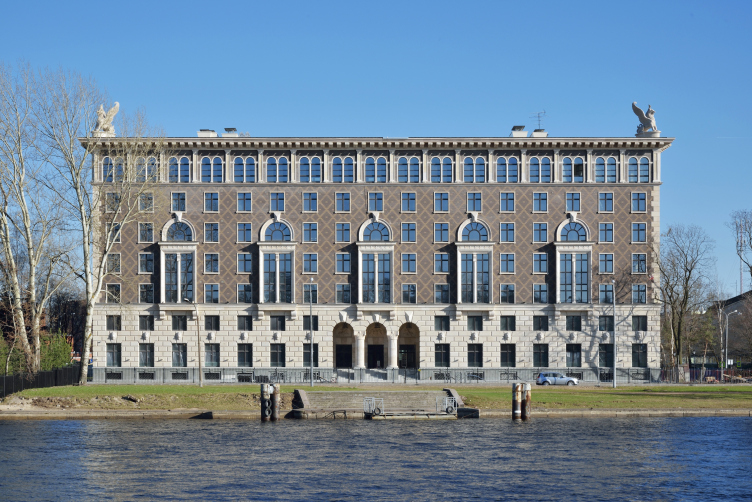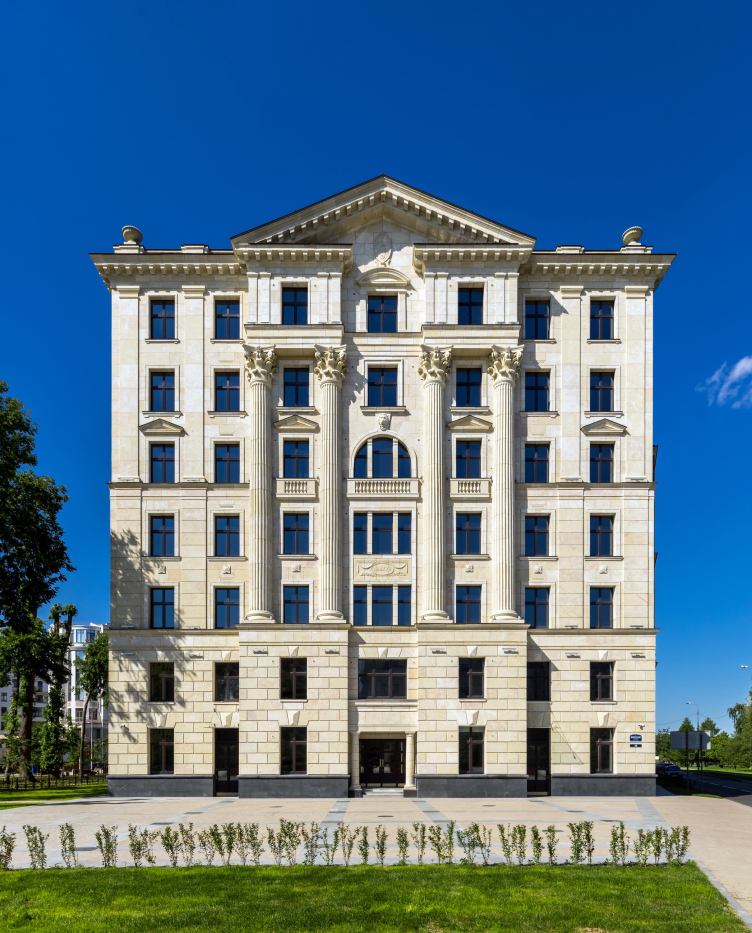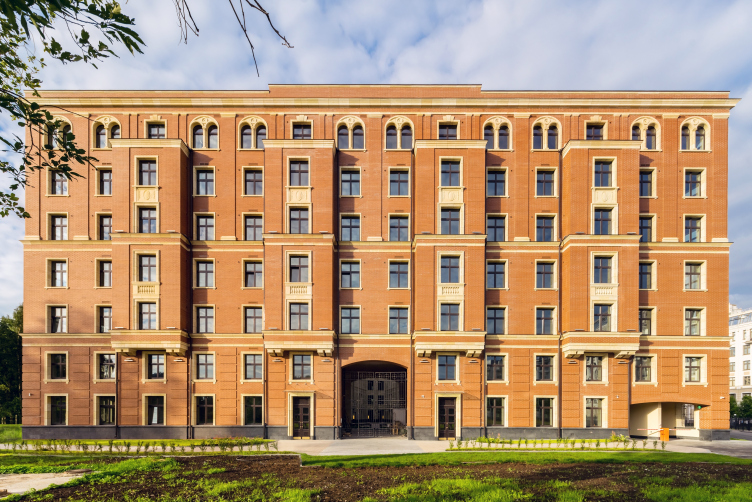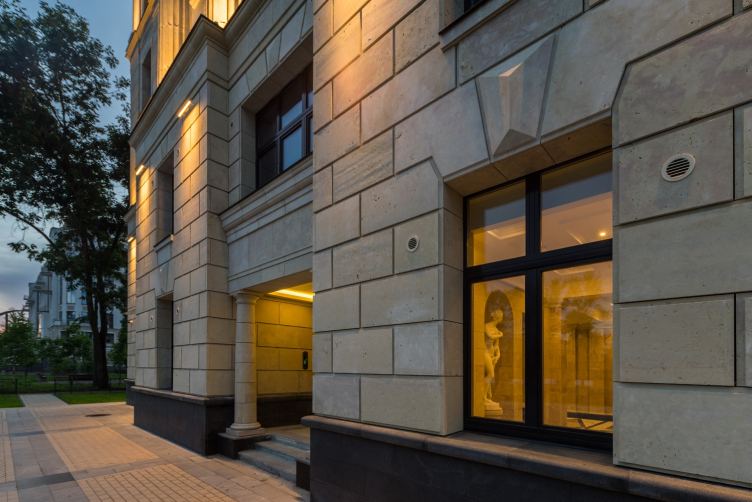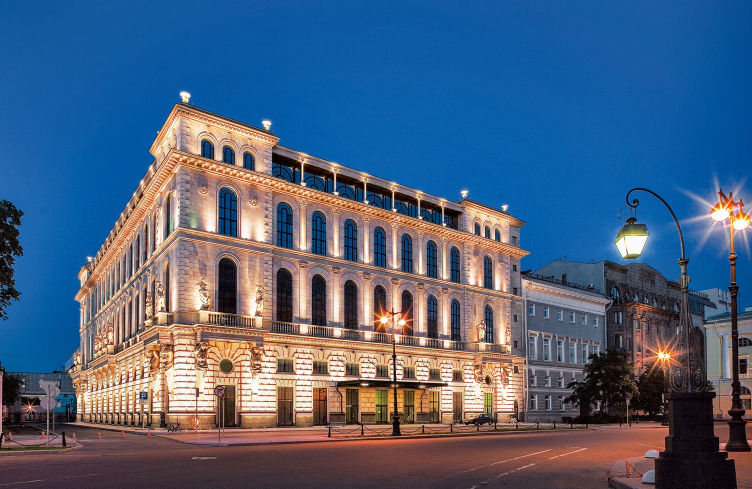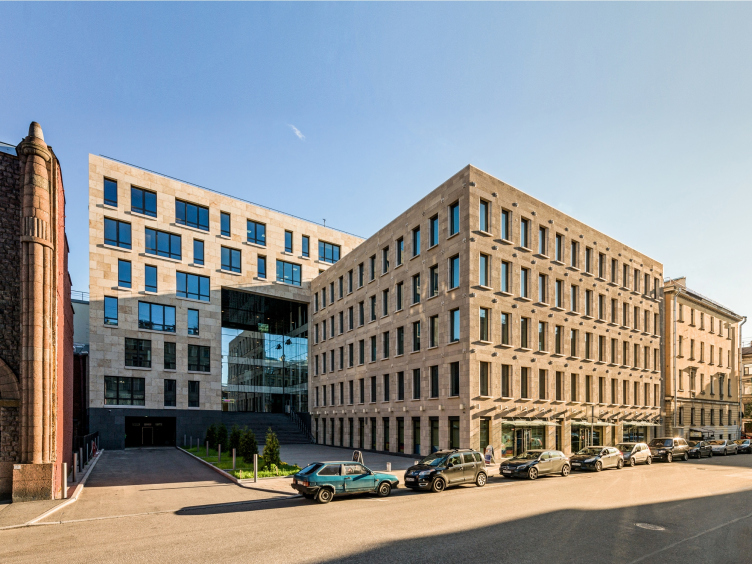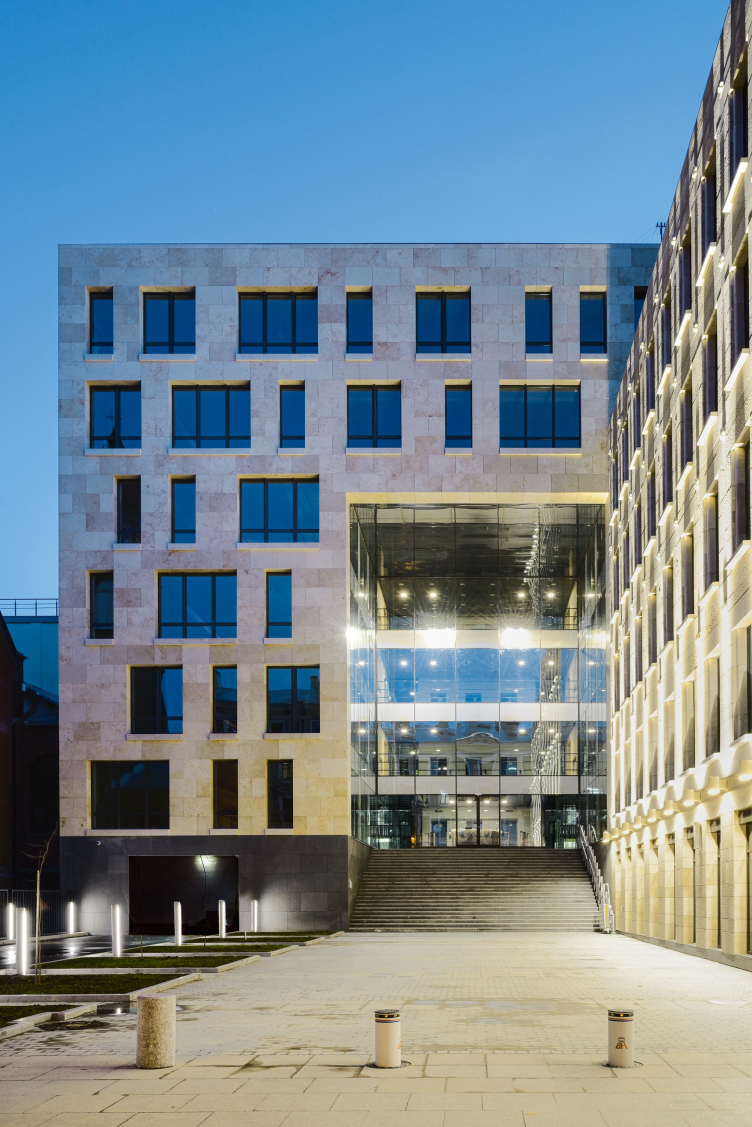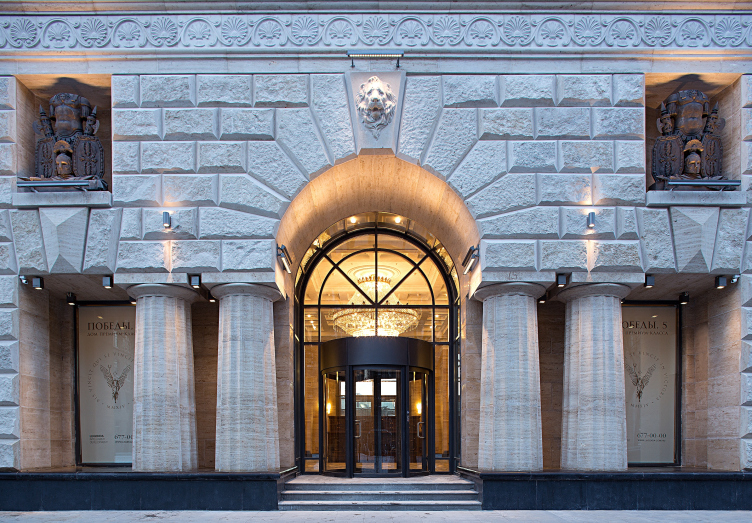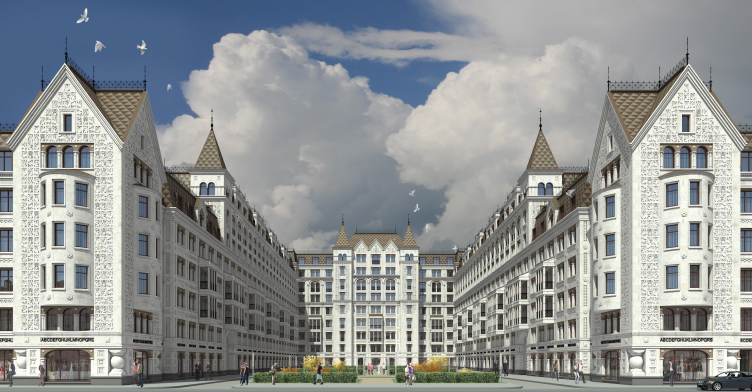Archi.ru
When we first analyzed the project of “Verona” house a couple of years ago, we discovered a lot of allusions: the Palladian order in combination with flutes, which are characteristic of historicism, the Saint Petersburg rock-face façades, the entrance stanza of lowered proportions, also characteristic of the northern Art Nouveau, the “Mussolini” approach toward combining brick and white stone on the side façades... What was the primary thing for you back then, and how did you build up the image of a palazzo house, which, obviously, in accordance with the client’s brief, was to look very much like the neighboring “Venice”?
Evgeny Gerasimov:
It was important for our client to boost the momentum of the commercially successful “Venice” house. What is Venice, anyway? As Brodsky put it, it is all about “huge wood-carved trunks standing alongside a channel”. And this is exactly what we got in our case. The aspect ratio of the width and the height of the building is two to one. Together with its reflection in the water, it becomes a quadrant – a totally Venetian technique. There is a staircase that survived from the Sportivnaya Hotel, which stood where the house was built; it descends down to the water, and there are posts sticking out of the water – you can tie gondolas to them.
"Venice" residential house © Evgeny Gerasimov & Partners
"Verona" housimg complex © Evgeny Gerasimov & Partners
First, while designing “Verona” house, we took into account the stylistic preferences of our client: “historicism” in a broad sense. Second, we proceeded from the land site; it became our starting point. Its trapeze-like shape prompted us the ideas of baroque architecture. We clearly saw the main façade overlooking the Morskoy Prospect, and the secondary ones from the side of the Prozhektornaya Street and the parks lying nearby. Hence the idea to do something in the vein of an Italian house. A few Italian churches also came to mind, such as San Giorgio Maggiore, houses on the Via del Corso, whose main façades are made of stone, while the lateral and the rear ones are made of brick. It was a practice usual for those days. As far as the building materials for both houses are concerned, we use the locally produced materials, manufactured in the Leningrad region: the Klinker brick is produced by the LSR Company; in the “Venice” project, Jurassic marble was used, while in “Verona” we used Gatchina Plaster.
"Verona" housimg complex © Evgeny Gerasimov & Partners
"Verona" housimg complex © Evgeny Gerasimov & Partners
How would you define the stylistic character of “Venice” and “Verona”: is it Palladian architecture, historicism, Venetian style?
I would not go as far as to narrow this whole thing down to Palladian architecture, and I would not call it neoclassical architecture either. This is historicism, our meditation on the subject of the traditional “order” architecture. We have been observing this process all throughout the history. It was originated by Palladio, then it was picked up by Quarenghi, who is known to have jokingly sign his works as “Shadow of Palladio”. Or take Ivan Fomin, for example – isn’t he neoclassical? If classics are Greece and Rome, then Palladio is neoclassical, Quarenghi is neo-neoclassical, and Ivan Fomin, well, you get it. The Stalin-era architecture is already the fourth or fifth revision of this tradition – if we are to divide the Stalin architecture into the prewar of the 1930’s and the postwar of the 1950’s. So, why not get back to this process in the beginning of the XXI century? As Alexander block would say, no art is “not new”.
"Verona" housimg complex © Evgeny Gerasimov & Partners
There are architects who preach classics as the only possible principle, such as Mikhail Filippov, Maxim Atayants, Mikhail Belov... There are also those who deliberately break up from the classical tradition. And there are very few architects out there who do sturdy historicism, and who are equally at home with Art Nouveau. How do you manage to do that?
A professional architect is supposed to be able to work in a variety of styles. Whether or not it is interesting to him is a different question. Speaking about historicism doesn’t yet mean that you are able to work in this style. Knowing notes alone does not make you a composer, and if you draw Piranesi Paestums, this doesn’t mean that you can design buildings. To me, words mean nothing and the result means everything. There are no taboos for me. In this day and age of pluralism, thank God, nobody owes anybody anything, and this is equally applicable to architecture. And art does not owe anyone anything either, it is self-sufficient. Good historicism is better than amateurish art nouveau, and vice versa. I vote for quality.
The hotel at the Ostrovsky Square © Evgeny Gerasimov & Partners
Do you perceive your historicist and modernist projects as equal? Which projects are more comfortable for you to work with, and which are more interesting?
It’s interesting to me to do creative search in both fields. I feel stale within just one paradigm, and I don't understand why I must narrow the field of my creative interests. Call this a lack of integrity if you want to but you can also remember Oscar Wilde who said “I like persons better than principles, and I like persons with no principles better than anything else in the world”. It’s the same way as it is with food: you cannot eat one dish during your whole life, even if it is your favorite. There are brilliant architects out there, like Richard Meier, for example, who do just one thing throughout their whole life – in his specific case, architecture that solely consists of white squares. But I’d be bored to death if I found out that my whole life I would only be drawing pilasters. I definitely want more.
To me, historicism is one of the branches of modern architecture that has a market segment of its own. Our company is also interested in rethinking and revisiting the traditional techniques in new building materials and technologies; we are interested in drawing and meditating. In addition, everyone thinks that something is beautiful is he or she is used to thinking that it’s beautiful. If we ask a hundred people what they like better: the neoclassical architecture of Ivan Fomin or August Perret or, say, a neo-constructivist building, the answer will be quite predictable. In this connection, Leon Krier asked himself a question: in which houses do “star” architects live, like Norman Foster or Jean Nouvel? You will find that nine out of ten will live in houses built in the XVIII and XIX centuries. And we as a company (and I as an architect) enjoy this search in both modernist and traditional architecture that rests on the human-friendly scale and the fundamentals that our ancestors found back in the day.
The residential house in the Kovensky Lane © Evgeny Gerasimov & Partners
As a continuation of the previous question – possibly, the house in the Kovensky Alley is indeed the perfect solution of a reserved regard to the context and the modern glass?
This area of the city includes a timeless heritage site – the Church of the Lourdes God’s Mother, designed by Leontiy Benoit and Matian Petetyatkovich. Competing with it in any way seemed to us the wrong thing to do. This place already had a gem in it – what we did was we came up with a worthy frame for it: we convinced the client to lower the building’s height, step back from the red line and make a piazzetta in the vacated room – the gem of the project. As a result, we opened up the west façade of the church, light started streaming through the windows into the central nave, and the stained glass windows came alive – this is something that this place had not seen before. The residential part, which steps out on the red line, is executed in the rhythm of Saint Petersburg: the pier is equal to the width of the window. The sunken-in part was also treated as a “Saint Petersburg firewall”: it is slightly higher, more flat, its windows are more chaotic, and there is less details upon it.
The residential house in the Kovensky Lane © Evgeny Gerasimov & Partners
What do you think of the very notion of “stylization”? Because you basically can stylize anything – including the modernist techniques.
Pretty much everything that came after the Ancient Greece and Rome is essentially stylization. It’s only a matter of whether it is appropriate or not. We see stylizations of gothic things, romanticism, and whatnot. Or take something that Matvey Kazakov did in Moscow. Try and open any modern magazine – what will you see in it if not stylization? Will you see anything that wasn’t done in the 1930’s or the exploits of the modernists of the 1960-1970’s? All the modern architecture comes down to a handful of techniques. Students from Finland to Portugal draw in the same way.
The residential house in the Kovensky Lane © Evgeny Gerasimov & Partners
If we are to take today’s stylizations, we will see an odd note of Stalin architecture showing through now and then. What is your attitude towards it? Do you try to chase it away without much success, or do you accept it as a historical given?
I am quite happy with it, in fact. One of the characteristic features of the Stalin architecture is the constant floor height. In classicism before the First World War, in the Russian empire style, and in the works by Quarenghi, the first floor inevitably performs the auxiliary function, while the second floor is a grander one with halls and luxury apartments. As you went higher up, the height of the floors would shrink, and, finally, the mansards were inhabited by students and small-time clerks. Then, as the social structure was leveled out by the October Revolution, the floor height was standardized as well. The floors became equally high, usually from the second to the last-but-one: while in the past century the mansards were for the Raskolnikovs, today the top floors are penthouses. This typology makes today’s architects akin to the Stalin’s.
The residential house, Pobedy, 5 © Evgeny Gerasimov & Partners
The Stalin-era architecture, whether we like it or not, is one of the greatest successes of this country. When we turned our backs on it, the great architects of the modernist tradition were surprised, to put it mildly: you Russians are weird, they’d say, you have such a great achievement, and you throw it overboard without thinking twice about it.
Take the acclaimed herzog & de meuron, who say: your Stalin architecture is so chic! It’s the apogee that most of today’s architects don’t even come close to.
It really stood the test of time. As for the Soviet architecture of the 1960-1970’s, which seemed to be advanced at the time, we now dismissively call it “khrushchevki” (“Khrushchev hacks”) – it did not stand the test of time. The Stalin architecture, on the other hand, is still standing strong; it does not annoy you, and this factor alone is quite a lot – not to annoy people with your appearance.
None
You have almost completed your “Russian House” project from the same historicist series. Which parts of this project do you consider to be successful and which could require some improvement?
The task was to build a big complex on a big land site. Essentially, its typology can be traced back to the Saint Petersburg tenement house: like the ones that you can see on Mokhovaya 27-29, Kamennoostrovsky 26-28, or like the Tolstoy House on the Rubinshteina Street. What we designed was one open courtyard and two private yards, from where the residents make it to their homes – the most traditional Saint Petersburg technique, really.
Multi-apartment building with integrated premises in Baskov Alley © Eugene Gerasimov and partners
The house is symmetrical from end to end, it has a main axis, each element and sub-element having an axis of its own, according to the same principle that the buildings of the Senate and Synod are designed upon. It’s flesh and blood Saint Petersburg.
The façades are essentially an attempt to rethink the pre-Peter the Great architecture, the so-called à la russe, on the Petrograd Side, on the Staronevsky Prospect, like the church built for the 300 anniversary of the Romanovs Royal House, or the Fedorovsky Gorodok in Tsarskoe Selo.
Saint Petersburg has always been trying to “rethink” its pre-Peter the Great architecture; we are getting back to the tradition that was broken for a hundred years for obvious reasons. This was provocative to the point of being risky: it’s easy to stoop down to kitsch in such cases. But we hope that we were ultimately able to keep the good manners.
Multi-apartment building with integrated premises in Baskov Alley © Evgeny Gerasimov and Partners
When I walk past this building, I see genuine interest: people are taking their pictures against the background of this building, examine its façade, and try to make out what it is made of. A person feels it in his gut, you cannot make somebody have their picture taken against the background of a black quadrant – even if a dozen critics explain that this is the latest big thing. And in this case, people come around of their own free will, without us having to talk to them and convince them. This means that there is something to it.
Do you have plans for developing this historicism theme? You have in your portfolio Renaissance historicism, the new-Russian style, and northern Art Nouveau, and even a “Stalin” house on the Pobedy Street – do want to give preference to any particular direction?
There is no such a given like “you need to develop this” carved in stone – we always proceed from the land site and from that fleeting feeling when you just see the right thing in a flash, from our intuition. We keep walking around the future construction site for a long time, looking and trying to imagine just what will be the right thing for the customer, and what will also be an exciting thing for us to do. Each land site has a latent need for change in it; you need to be able to hear the whisper of the place.

